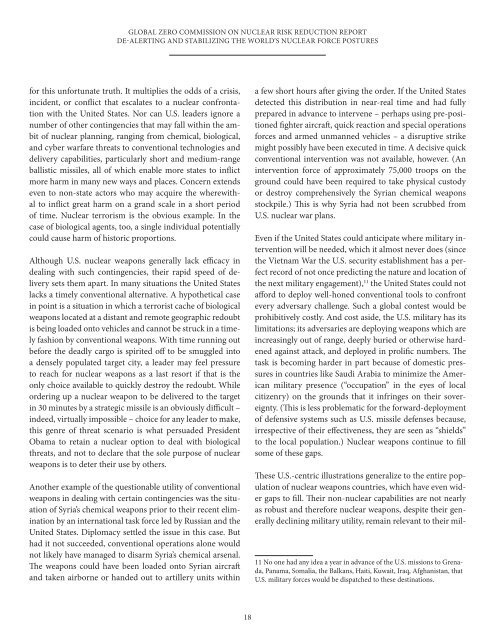global_zero_commission_on_nuclear_risk_reduction_report
global_zero_commission_on_nuclear_risk_reduction_report
global_zero_commission_on_nuclear_risk_reduction_report
Create successful ePaper yourself
Turn your PDF publications into a flip-book with our unique Google optimized e-Paper software.
GLOBAL ZERO COMMISSION ON NUCLEAR RISK REDUCTION REPORTDE-ALERTING AND STABILIZING THE WORLD’S NUCLEAR FORCE POSTURESfor this unfortunate truth. It multiplies the odds of a crisis,incident, or c<strong>on</strong>flict that escalates to a <strong>nuclear</strong> c<strong>on</strong>fr<strong>on</strong>tati<strong>on</strong>with the United States. Nor can U.S. leaders ignore anumber of other c<strong>on</strong>tingencies that may fall within the ambitof <strong>nuclear</strong> planning, ranging from chemical, biological,and cyber warfare threats to c<strong>on</strong>venti<strong>on</strong>al technologies anddelivery capabilities, particularly short and medium-rangeballistic missiles, all of which enable more states to inflictmore harm in many new ways and places. C<strong>on</strong>cern extendseven to n<strong>on</strong>-state actors who may acquire the wherewithalto inflict great harm <strong>on</strong> a grand scale in a short periodof time. Nuclear terrorism is the obvious example. In thecase of biological agents, too, a single individual potentiallycould cause harm of historic proporti<strong>on</strong>s.Although U.S. <strong>nuclear</strong> weap<strong>on</strong>s generally lack efficacy indealing with such c<strong>on</strong>tingencies, their rapid speed of deliverysets them apart. In many situati<strong>on</strong>s the United Stateslacks a timely c<strong>on</strong>venti<strong>on</strong>al alternative. A hypothetical casein point is a situati<strong>on</strong> in which a terrorist cache of biologicalweap<strong>on</strong>s located at a distant and remote geographic redoubtis being loaded <strong>on</strong>to vehicles and cannot be struck in a timelyfashi<strong>on</strong> by c<strong>on</strong>venti<strong>on</strong>al weap<strong>on</strong>s. With time running outbefore the deadly cargo is spirited off to be smuggled intoa densely populated target city, a leader may feel pressureto reach for <strong>nuclear</strong> weap<strong>on</strong>s as a last resort if that is the<strong>on</strong>ly choice available to quickly destroy the redoubt. Whileordering up a <strong>nuclear</strong> weap<strong>on</strong> to be delivered to the targetin 30 minutes by a strategic missile is an obviously difficult –indeed, virtually impossible – choice for any leader to make,this genre of threat scenario is what persuaded PresidentObama to retain a <strong>nuclear</strong> opti<strong>on</strong> to deal with biologicalthreats, and not to declare that the sole purpose of <strong>nuclear</strong>weap<strong>on</strong>s is to deter their use by others.Another example of the questi<strong>on</strong>able utility of c<strong>on</strong>venti<strong>on</strong>alweap<strong>on</strong>s in dealing with certain c<strong>on</strong>tingencies was the situati<strong>on</strong>of Syria’s chemical weap<strong>on</strong>s prior to their recent eliminati<strong>on</strong>by an internati<strong>on</strong>al task force led by Russian and theUnited States. Diplomacy settled the issue in this case. Buthad it not succeeded, c<strong>on</strong>venti<strong>on</strong>al operati<strong>on</strong>s al<strong>on</strong>e wouldnot likely have managed to disarm Syria’s chemical arsenal.The weap<strong>on</strong>s could have been loaded <strong>on</strong>to Syrian aircraftand taken airborne or handed out to artillery units withina few short hours after giving the order. If the United Statesdetected this distributi<strong>on</strong> in near-real time and had fullyprepared in advance to intervene – perhaps using pre-positi<strong>on</strong>edfighter aircraft, quick reacti<strong>on</strong> and special operati<strong>on</strong>sforces and armed unmanned vehicles – a disruptive strikemight possibly have been executed in time. A decisive quickc<strong>on</strong>venti<strong>on</strong>al interventi<strong>on</strong> was not available, however. (Aninterventi<strong>on</strong> force of approximately 75,000 troops <strong>on</strong> theground could have been required to take physical custodyor destroy comprehensively the Syrian chemical weap<strong>on</strong>sstockpile.) This is why Syria had not been scrubbed fromU.S. <strong>nuclear</strong> war plans.Even if the United States could anticipate where military interventi<strong>on</strong>will be needed, which it almost never does (sincethe Vietnam War the U.S. security establishment has a perfectrecord of not <strong>on</strong>ce predicting the nature and locati<strong>on</strong> ofthe next military engagement), 11 the United States could notafford to deploy well-h<strong>on</strong>ed c<strong>on</strong>venti<strong>on</strong>al tools to c<strong>on</strong>fr<strong>on</strong>tevery adversary challenge. Such a <str<strong>on</strong>g>global</str<strong>on</strong>g> c<strong>on</strong>test would beprohibitively costly. And cost aside, the U.S. military has itslimitati<strong>on</strong>s; its adversaries are deploying weap<strong>on</strong>s which areincreasingly out of range, deeply buried or otherwise hardenedagainst attack, and deployed in prolific numbers. Thetask is becoming harder in part because of domestic pressuresin countries like Saudi Arabia to minimize the Americanmilitary presence (“occupati<strong>on</strong>” in the eyes of localcitizenry) <strong>on</strong> the grounds that it infringes <strong>on</strong> their sovereignty.(This is less problematic for the forward-deploymentof defensive systems such as U.S. missile defenses because,irrespective of their effectiveness, they are seen as “shields”to the local populati<strong>on</strong>.) Nuclear weap<strong>on</strong>s c<strong>on</strong>tinue to fillsome of these gaps.These U.S.-centric illustrati<strong>on</strong>s generalize to the entire populati<strong>on</strong>of <strong>nuclear</strong> weap<strong>on</strong>s countries, which have even widergaps to fill. Their n<strong>on</strong>-<strong>nuclear</strong> capabilities are not nearlyas robust and therefore <strong>nuclear</strong> weap<strong>on</strong>s, despite their generallydeclining military utility, remain relevant to their mil-11 No <strong>on</strong>e had any idea a year in advance of the U.S. missi<strong>on</strong>s to Grenada,Panama, Somalia, the Balkans, Haiti, Kuwait, Iraq, Afghanistan, thatU.S. military forces would be dispatched to these destinati<strong>on</strong>s.18


